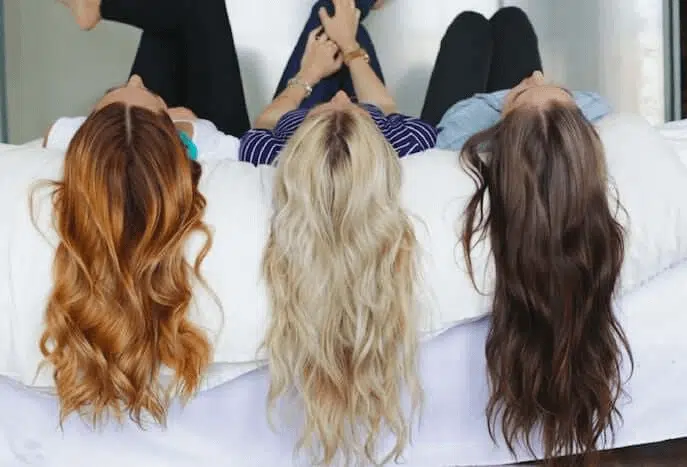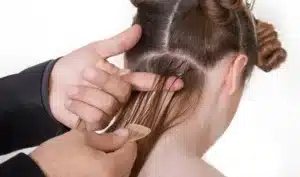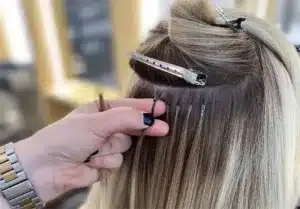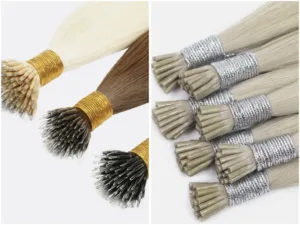You see it all the time: beautiful hair installed in the wrong length. The result looks off. Clients complain. Returns rise. The fix is a clear, exact way to pick length.
Choose lengths by body height, natural hair, texture, target effect, method, and grams. Measure from the nape, convert for curl, then match weight to length for clean blending and long wear.

Length is not only a number on a tag. It changes with height, neck length, shoulder width, curl pattern, and application method. The following framework helps salons, pro stylists, and wholesale buyers select fast, blend clean, and control cost-per-wear.
Why is Choosing the Right Length Important?
Clients judge results first by shape and line. If the line ends too high or drags too low, the eye catches it at once. Photos make it worse. Your team then spends time re-cutting, adding packs, or handling returns.
The right length frames the face, matches daily habits, protects the scalp, and keeps re-installs on schedule. It also manages torque (pull) on attachment points during washing, sleeping, and ponytails. Less torque means fewer slips and fewer repairs. With correct length, grams go where they matter and you avoid thin, see-through ends. You also keep the client inside a realistic home-care window. Dry times stay normal. Detangling stays quick. Clients rebook confidently, which stabilizes revenue.
Length choice also affects inventory. Longer hair ties up more cash, needs more grams, and moves slower. Correct planning reduces dead stock and protects margins. When you connect length with clear “target effects” (volume boost vs dramatic change), consults become simple. The client points to a landmark; you measure and decide. No guessing. No waste.
Factors to Consider When Choosing Extension Length
Many length errors come from missing one factor. Use the full set below. Tie each factor to a measurable action in consult and ordering.
Client’s Target Effect (the outcome they actually want)
- Volume only (keep near current length; +2–4 inches max)
- Subtle length (below-shoulder to mid-back; +4–6 inches)
- Glam/waist look (22–24 inches; higher grams; higher care)
- Editorial/extra long (26+ inches; niche use; high torque)
Ask the client to point to a body landmark (clavicle, bust, below-bust, waist). Photograph the back with a test strand at that spot. Align everyone on the same visual.
Body Metrics
- Height changes where each tag length lands.
- Neck length and shoulder slope shift the line.
- Broad shoulders shorten the visual drop because hair rests and spreads.
Mark three cape landmarks (clavicle, bust, waist). Record inches from nape to each.
Natural Hair Length, Thickness, and Baseline Shape
- Blunt lobs need more grams and sometimes +1–2 inches for blending.
- Layered baselines blend faster and may allow a shorter tag.
- Very thick natural hair needs higher grams to avoid a “step.”
Textures of Hair Extensions (and curl shrinkage)
Different textures read shorter when dry. Factory tag length is measured stretched. Plan the tag to match the dry goal.
| Texture | Dry “reads like” vs tag | Notes |
|---|---|---|
| Straight | Same as tag | Most predictable |
| Body wave (air-dry) | −1.5 to −2 in | Blows out to tag length |
| Loose curl | −2 to −3 in | Add grams for full ends |
| Tight curl/coily | −3 to −5 in | Use stretch-length ring at consult |
Application Method and Attachment Map
- Weft rows sit slightly outside head shape; they can read ~0.5 inch shorter.
- Tape-ins lie flat; they can read true-to-tag or slightly longer.
- Keratin bonds allow micro mapping near crown; this can add the illusion of length.
Density Target and Grams
Longer lengths need more grams to avoid stringy ends. Thin hair needs enough grams to hide shelves. Use a grams table tied to length and head size.
Lifestyle and Maintenance Window
- High-activity clients should avoid extreme lengths; torque rises.
- Frequent swimmers should avoid very long blondes; dry time and care rise.
- Heat styling every day shortens lifespan; keep lengths practical.
Budget and Stock Strategy (for salons and wholesalers)
Anchor inventory in 18–22 inches (natural shades). Offer 24–26 inches via pre-order. Protect cash flow and align grams with your market’s average height and target effects.
How Does Height Affect Your Hair Extensions Length?
The same tag length lands differently on different bodies. A 22-inch set can be below-bust on a petite client, but mid-back on a tall client. Tie length to height and landmarks to avoid surprises.
Guide (straight hair, average neck/torso; measured from nape)
| Height | 16″ | 18″ | 20″ | 22″ | 24″ |
|---|---|---|---|---|---|
| 150–158 cm (4’11″–5’2″) | Upper chest | Bust | Below bust | Upper waist | Mid waist |
| 160–168 cm (5’3″–5’6″) | Clavicle–upper chest | Upper bust | Bust | Below bust | Upper waist |
| 170–178 cm (5’7″–5’10”) | Clavicle | Upper chest | Upper bust | Bust | Below bust |
Adjust −2 to −5 inches visually for curly textures worn air-dry. Add +1 inch allowance when heavy beveling or face-framing is planned.
How to Choose the Right Hair Extensions Lengths
Turn consults into a repeatable process. Use a five-minute workflow that any stylist can follow and that buyers can map to purchase orders.
Step-by-step protocol
- Map landmarks: Mark clavicle, bust, and waist on the cape.
- Measure from nape: Note inches from nape to the client’s chosen landmark.
- Convert for texture: Add 2 inches for wavy, 3–4 inches for curly/coily (air-dry wear).
- Adjust for method: Add ~0.5 inch for weft rows; no change for tapes/keratin.
- Check base cut: Add +1–2 inches if the baseline is blunt and above shoulder.
- Match grams: Use the grams table to keep the perimeter full.
- Confirm with strands: Pin 2–3 test strands at the target length; take a quick photo.
- Lock the order: Length, grams, method, shade, and any blending pack.
Grams by length (baseline, average head; straight/wavy)
| Length | Clip-ins total | Tape-ins total | Weft rows (hand-tied/genius) |
|---|---|---|---|
| 14–16″ | 120–140 g | 160–180 g | 1 row (60–80 g) |
| 18″ | 140–160 g | 180–200 g | 1–2 rows (80–120 g) |
| 20″ | 160–180 g | 200–220 g | 2 rows (100–140 g) |
| 22″ | 180–200 g | 220–260 g | 2 rows (120–160 g) |
| 24″ | 200–240 g | 260–300 g | 2–3 rows (160–200 g) |
Add 20–40 g for blunt baselines or thick natural hair. Add 10–20 g for curls to keep ends full after shrinkage.
Measuring Length Correctly: Straight vs Wavy vs Curly
Most disputes come from mixed measurement methods. Factory tag length is stretched. Clients see dry, natural fall. Align both.
Best practice
- Always measure from the nape (where attachments start).
- Use a stretch-length ring next to a soft tape.
- Show the client a dry “wear length” photo reference for each texture.
- If cutting a bevel, expect to lose ~0.5–1 inch at the longest point.

Quick conversion
- Body wave: tag equals blowout; −1.5–2 inches air-dry.
- Loose curl: −2–3 inches air-dry.
- Tight coil: −3–5 inches air-dry.
Document the conversion on the client card so re-installs match the first result.
Effects of Different Lengths
Length is not only reach. It sets mood, movement, and maintenance. Use this section to connect choice with the client’s lifestyle and brand image.
Length-to-effect map
| Length | Visual effect | Styling range | Care load | Best for |
|---|---|---|---|---|
| 14–16″ | Natural, polished | Blowout, soft waves | Low | Everyday wearers, corporate |
| 18–20″ | Versatile, photo-ready | Waves, curls, half-up | Medium | Brides, content creators |
| 22–24″ | Glam, red-carpet | Big curls, high pony | Medium-high | Events, stage, editorial |
| 26–28″ | Dramatic, statement | Sleek, avant-garde | High | Fashion shoots, niche looks |
Movement and torque
Longer lengths increase swing and leverage on bonds. High ponytails and wet hair raise torque. If the client wears gym ponytails daily or swims often, keep under below-bust or increase rows and grams to spread load. For curls, remember that dry length reads shorter, but weight still matches the tag. Plan grams for health and comfort.
Length vs Weight: Keep Ends Full and Installs Stable
Weight must scale with length. If grams stay low while length goes up, the perimeter thins and the eye reads “cheap.” If grams go too high on short lengths, the head feels bulky and tension rises.

Fast rules
- Under 18″: lighter totals blend fine unless the base is blunt.
- 20–22″: standard totals above work for most heads.
- 24–26″: plan the upper band of the table and consider a third row.
- Blunt baselines: add a short blending pack (one step shorter) under the perimeter.
For wholesale planning, make 18–22 inches your core with GN/hand-tied skus at 100–160 g per head. Offer 24–26 inches as controlled stock or pre-order to protect cash.
Everyone sees the same five errors. Build your fix kit and your prevention checklist.
1
Let’s see an example
1
The world of hair extensions offers a plethora of lengths to cater to every desire and to suit every personality. Understanding the visual and style impacts of these lengths can be your secret weapon to achieving the look of your dreams. Let’s delve deeper:
12-14 Inches: This is your ‘everyday glam’ range. Especially harmonizing for short to medium hair, it provides that hint of playfulness without being overly dramatic. The extensions gracefully touch the shoulders, gifting you with a bouncy and youthful vibe.
1

1
16-18 Inches: Enter the ‘classic beauty’ zone. Hitting around the bust area, it’s versatile and the sweet spot for many. This length is neither too short nor extravagantly long, and thus, it suits a vast majority. It’s just right for those wanting to achieve a sleek, polished, and sophisticated aura.

1
1
20-22 Inches: This length can be termed as the ‘boho chic’ realm. Cascading down the back, they can be a dream for those into loose waves or dreamy braids. Perfect for free spirits wanting a touch of whimsy and magic in their locks.
1

1
24-26 Inches: Here’s where drama meets elegance, the ‘red carpet ready’ range. Ideal for the daring souls out there or those whose natural hair already touches their lower back and are seeking that extra oomph. It offers a mermaid-like allure, with hair that sways with every step and is bound to turn heads.
1

1
28 Inches and Above: The ‘ultimate diva’ zone. This range is for those who want to make an unforgettable statement. It demands attention and care but is worth every second spent on it. If you’re in for the ultra-glam look, this is your playground.
1

Common Mistakes and Fast Fixes
1
Beyond just the aesthetics, remember that the length also dictates the weight and the pull on your natural hair. While a long cascade of hair sounds dreamy, ensure it aligns with your daily routine, lifestyle, and comfort level.
| Mistake | Symptom | Fast fix | Prevention |
|---|---|---|---|
| Ignored height | Lands short of target | Add a few longer pieces at back; soften layers | Use height-landmark chart every consult |
| Underestimated curl shrinkage | Dry read too short | Add longer pieces low in the back | Convert tag for texture; show stretch ring |
| Too few grams for length | See-through ends | Add micro-pack at perimeter | Tie grams to length and base cut |
| Blunt shelf visible | Step line | Short blending pack; internal layers | Note base cut; pre-plan grams +1 step |
| Over-trimming | Missed goal | Blend ends only; stop, check, refine | Cut less; document target landmark |
Keep emergency packs in neutral shades (short/blending and long/filler). These save appointments and reviews.
Regional Preferences and SKU Strategy (for Salons and Wholesalers)
Length demand changes by market culture, height profile, and media trends. Align stock to your local data.
- Urban markets: higher 22–24 inch demand, more wefts/genius rows.
- Suburban markets: 18–20 inch, strong tape-in and clip-in mix.
- Bridal seasons: lift in 20–22 inch, soft waves.
- Festival seasons: lift in curly textures, brighter shades, and longer lengths.
Use a 70/20/10 mix: 70% core (18–22 in, natural shades), 20% seasonal (blondes, curls), 10% special (24–26 in) with pre-order.
My opinion
From a manufacturer’s perspective, the cleanest installs come from a simple discipline: measure from the nape, convert for texture, and tie grams to length and base cut. When teams add the client’s “target effect” as the first question, the rest falls into place. That one change reduces returns, stabilizes re-installs, and keeps inventory lean.
FAQ
Q1. What length sells best for salons?
18–20 inches lead because they fit most heights and read natural in photos while staying easy to maintain.
Q2. How much longer than natural hair should you go for a subtle change?
Add 4–6 inches. It blends smoothly and avoids a dramatic step.
Q3. How much extra length should you order to allow trimming?
Plan ~2 inches over the final goal for beveling and face-framing.
Q4. Do curls always need a longer tag?
Yes, if worn air-dry. Body wave: +2 inches; loose curl: +2–3; tight coil: +3–5 vs the straight tag.
Q5. Do longer lengths always need more grams?
Yes. Spread over more inches, the same grams look thin. Use the grams table and add 10–20 g for curly textures.
Q6. Which method looks “longest” at the same tag?
Tapes often read true-to-tag or a touch longer. Weft rows can read ~0.5 inch shorter. Keratin can look longer due to crown mapping.
Q7. How does a blunt bob affect length choice?
It demands either more grams or a short blending pack. Many installs also step up the tag by +1 inch to clear the shelf.
Q8. Can petites wear 24 inches?
Yes, but plan for torque, dry time, and care. Many petites are happier at 20–22 inches with correct grams.
Q9. What if the client wants “volume only” with no visible length change?
Match the tag to current length or +2 inches max and increase grams in the lower third for fullness.
Q10. What lengths work best for high ponytail lovers?
Keep under below-bust or increase rows to spread load. Consider lighter densities to reduce swing torque.
Q11. How should wholesalers plan stock by length?
Anchor 18–22 inches in natural shades. Offer 24–26 inches via pre-order. Maintain blending packs for problem baselines.
Q12. Do lighter blonde shades at long lengths need extra care?
Yes. They dry slower, show wear sooner, and can read thinner. Add grams and set clearer home-care rules.
Q13. How do you handle clients between two lengths (20 vs 22)?
Pin test strands at both. Take back-view photos. Let the client choose with eyes open. If undecided, pick the shorter with better grams.
Q14. Does head size change the grams plan?
Yes. Larger heads need wider maps or more grams to keep the perimeter full at longer lengths.
1
1
1
CONCLUSION
1
Hair extensions are a bit like magic – the right length can make you feel like a whole new you! Each length tells its own story, frames the face differently, and captures a distinct essence.With these tips in hand, anyone from curious consumers to seasoned stylists will be flipping their perfect locks in no time. So, go on, let your hair do the talking!




